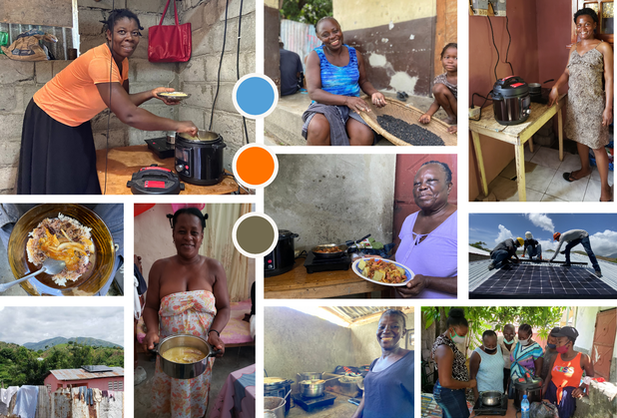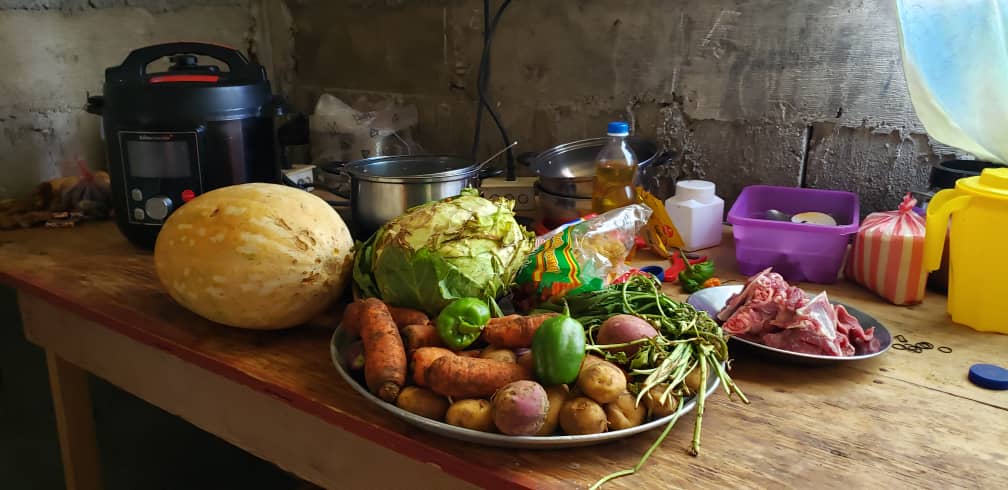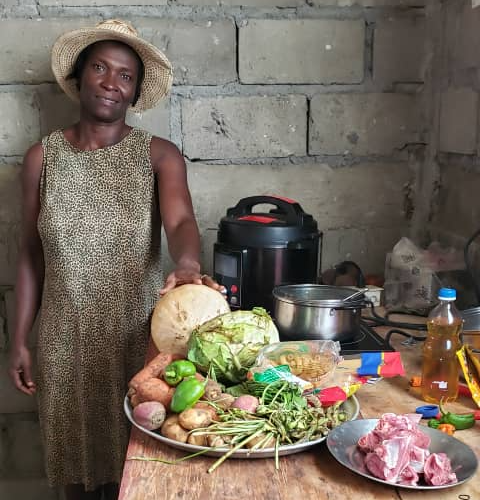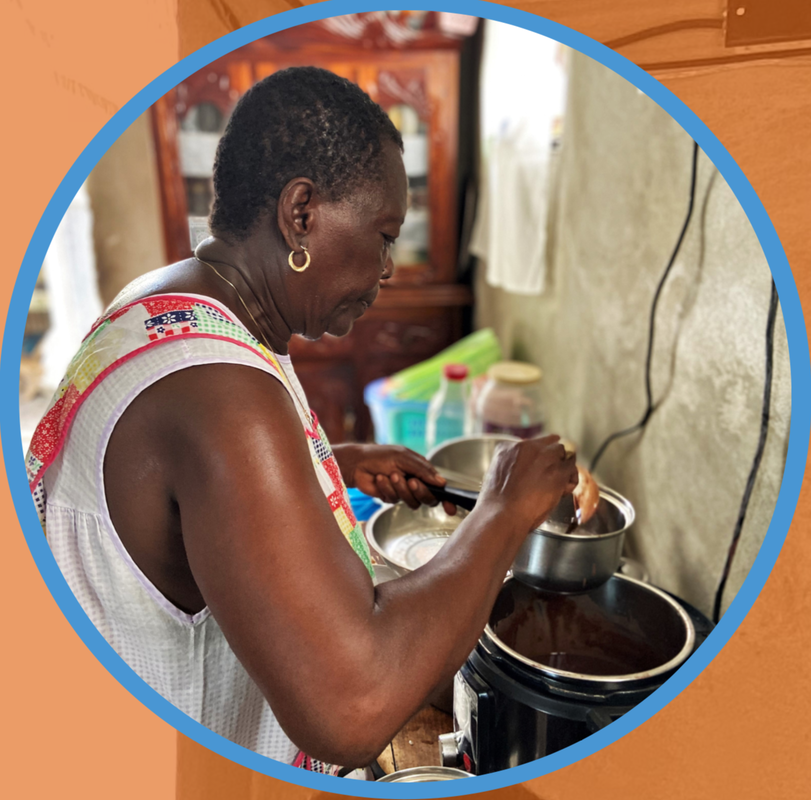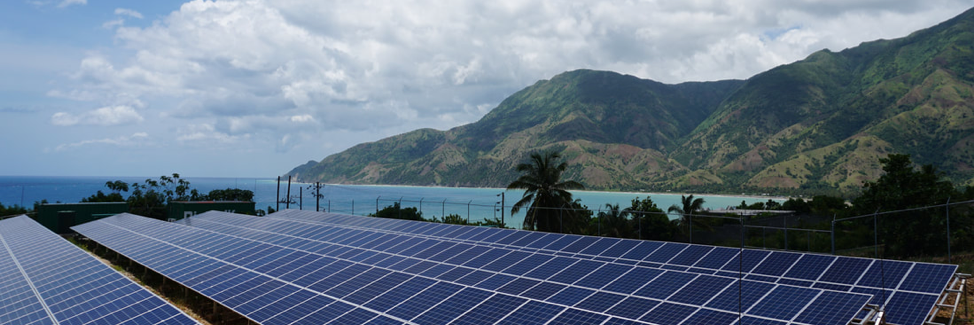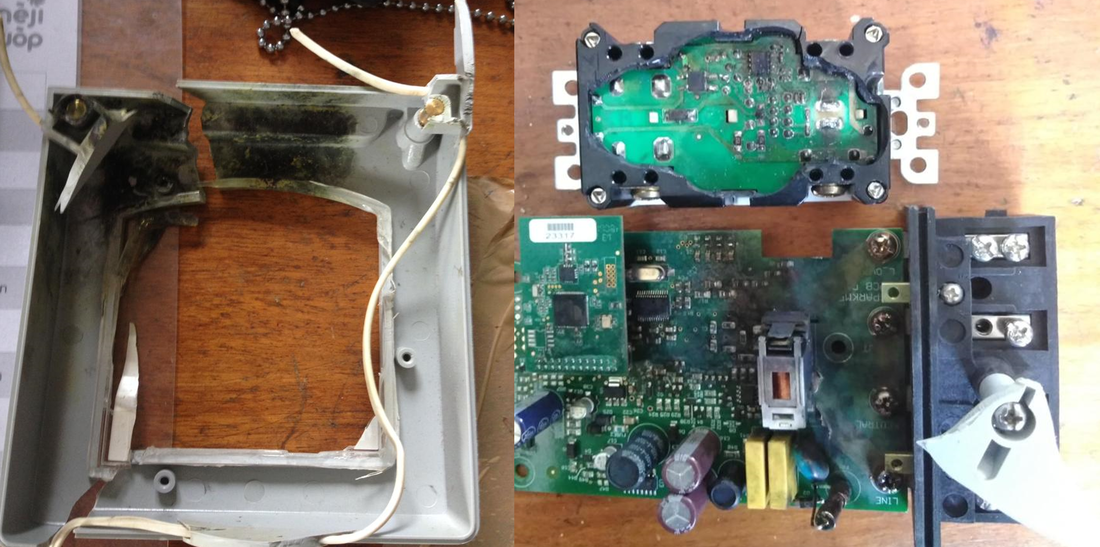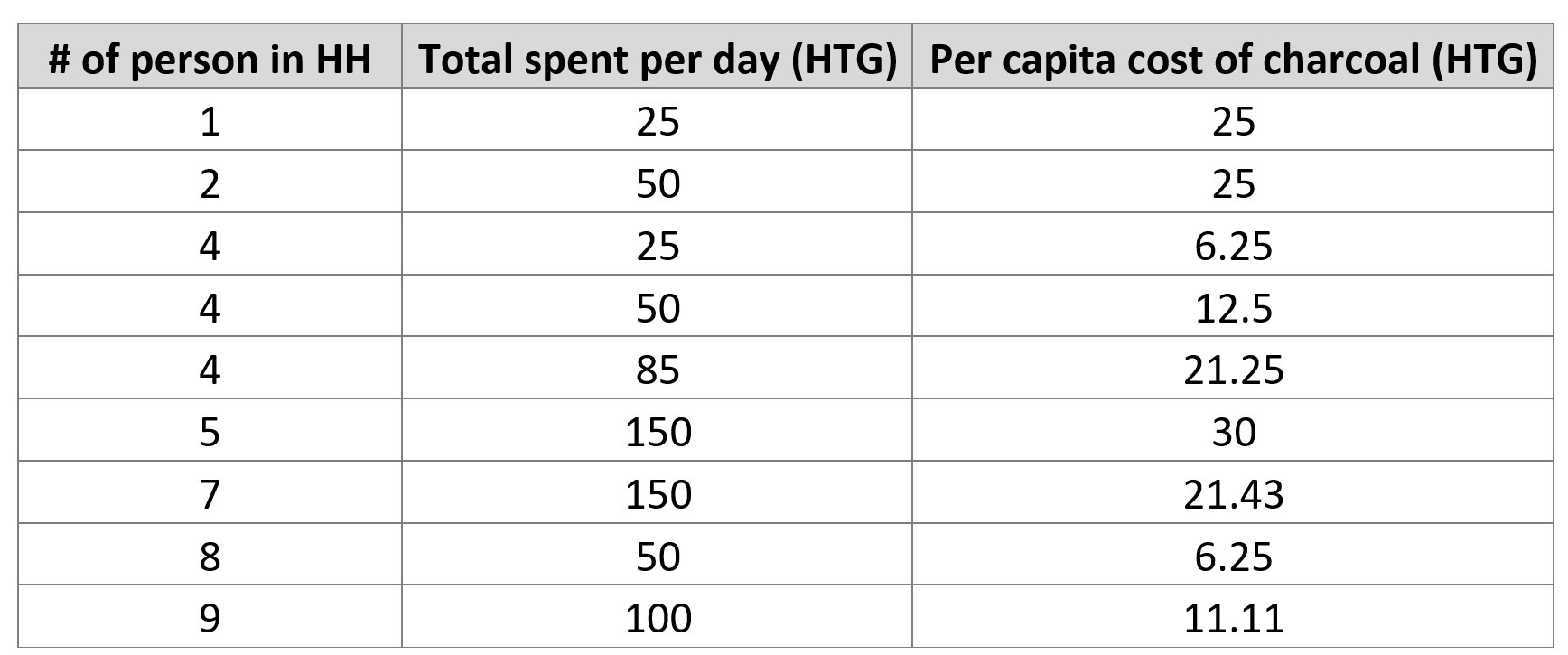|
This weekend Americans celebrate a bold declaration. It wasn’t itself enough, but it was a pivotal piece of what has become history. What will our era’s contribution be? This may be our moment. Let us rise to the occasion. As the United States sees the impacts of climate change but wavers on taking meaningful action to address it, it feels like there is hesitation or inability to state and embrace the obvious: we need to stop using fossil fuels, and we need to act quickly. Everything we need is within reach. Details matter, but only if the big picture is well defined. From our small perch on the planet, the EarthSpark team has already committed to shifting to 100% renewable energy for our electricity systems in Haiti. It turns out that relying on even a small amount of fossil fuels where we work is extremely expensive and difficult to manage. For us, the shift to 100% is already here. “It’s not only possible, it’s happening!” says Wendy Sannassee. If our tiny organization can go 100% renewable energy in rural Haiti, the United States of America can also get this done! Ready for a smile and a shot of can-do-ism? Is the transition to 100% renewable energy possible? Of course it is! say the members of the EarthSpark team. Together, let’s all speed up the transition and get better energy everywhere.
The spirit of this email is celebratory and encouraging, but we also want to share that things are very hard in Haiti right now. Our team is ok, but many are not so lucky. Gang violence and COVID are both surging. The vaccine has not arrived. Hunger and physical insecurity are widespread. A political crisis is coming to a head, and the season’s first hurricane is currently tracking towards the coast. It’s a sobering time, but the best answer is always grounded optimism and the diligence to follow it up. If you can support our work, please consider making a donation here. Oh, and please spread the word in your communities about the urgency and our ability to make some bold declarations of independence from the oppressive systems – fossil fuels and otherwise – that we currently face.
0 Comments
by Andy Bilich
EarthSpark is delighted to announce the release of "Kwison Elektrik: Solar Power for Electricity Access and Electric Cooking in Haiti." The report, in partnership with SUNSPOT™ and with the UK Government's Modern Energy Cooking Services (MECS) program details the pilot project A research project in rural Haiti demonstrates the effectiveness of electric cooking technologies powered by solar microgrids to improve the quality of life for community members while generating new revenue streams and opportunities for energy access providers. The full report is available for free download here. Executive Summary: Around the world, people are realizing that fire-based cooking is neither good for the cooker nor for the climate. As urban centers with natural gas infrastructure grapple with transitioning off fossil fuels for cooking, over 2.8 billion people are still relying on biomass or kerosene to cook. Traditional cooking fuels are often expensive, bad for people’s health, and bad for the environment. “Black carbon” soot from cooking smoke lands on glaciers and lodges deep in people’s lungs. The tiny particles accelerate climate change and kill millions of people—mostly women—each year. Global “clean cooking” efforts have focused on improved cookstoves, biomass briquettes, and expansion of LPG. However, clean cooking has lagged significantly compared to the need, and the solutions have often not fully solved the problems. Recent initiatives focusing on electric cooking are a welcome shift. For too long access to electricity and access to improved cooking technology have been siloed. Combining the two issues has the potential to more effectively meet people’s basic needs while boosting the business model for solar-powered electricity systems in remote communities. This study explores the potential of electric cooking in rural Haiti by deploying electric pressure cookers and induction stoves with integrated smart meters in 20 households connected to a community scale solar PV microgrid as well as cookers and stoves supported by stand-alone solar+battery systems in 8 off-grid households. Overall, the pilot project has showcased the value of electric cooking for both local communities and microgrid operators. Key findings indicate that electric cooking in this context is a:
Today is Independence Day in Haiti, commemorating the Declaration of Independence in 1804 which concluded the first and only successful state-scale black slave rebellion of the colonial era. To celebrate, many families in Haiti and around the world will be celebrating with a soup. The hearty squash-based soup joumou was profiled in the New York Times this week as a symbol of nourishment, generosity, family, pride, racial equality, history, and aspirations, all stewed together and eaten in community. In Les Anglais this year, Marie André will be cooking soup joumou in her electric kitchen with microgrid electricity powered by the sun. She came to the clean energy store today to top up her electricity account before the holiday and kindly agreed to pile up her soup ingredients for this photo. “Anyone who is against oppression and stands for justice and freedom for all people should be proud, and celebrate that first victory for enslaved Africans against their oppressors,” Manie Chery, creator of the popular “Love for Haitian Food” website and YouTube channel told the Times. We were thrilled to see Ms. Chery post her own electric cooking Soup Joumou recipe today : Instant Pot Soup Joumou (!)
How will the two electric cooking soups compare? We’ll need to wait for some comparative taste test results to find out! In the meantime, we are sending you warm wishes for good health, happiness, and great progress toward realizing shared dreams in 2021. To continued revolution and renewal towards a better world for all, The EarthSpark and Enèji Pwòp teams This post is an adaptation of an EarthSpark International newsletter. Sign up here to stay plugged in to EarthSpark's ongoing participatory clean energy work in Haiti. 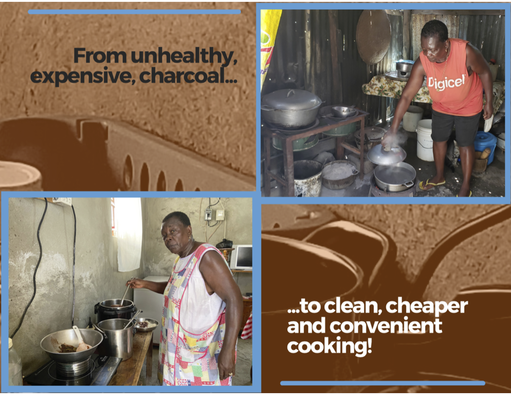 When Madame Agatte woke up in the middle of the night feeling sick last month, she also felt a sense of relief. To make an herbal tea - which would have taken her nearly an hour with her charcoal stove - she didn't need to go outside and light a fire. Madame Agatte went to her newly electric kitchen, boiled water, and 10 minutes later was sipping a soothing drink. Madame Agatte is one of the participants in EarthSpark's electrification of cooking pilot program in Les Anglais. Through this project 29 households are now using electric pressure cookers and induction stoves to cook meals for over 120 people. Each of the households have participated in hands-on trainings with the devices. After one month of electric cooking, participants are excited about the benefits and opportunities of electric cooking:
Click here to see the tea recipe and Madame Agatte's black bean sauce recipe! EarthSpark and the study participants will track cooking trends and attitudes over the next few months. This will help create a strong evidence-base for expanding opportunities for clean electric cooking in other communities in Haiti and around the world. Keep an eye out for upcoming reports and mini-documentaries on our clean cooking work! What was the last new technology that you adopted, and how has it changed your life? EarthSpark's president, Allison Archambault's recently posted TEDx talk about our work in Haiti and her own adventures in electric cooking remind us that from Marie Agathe's kitchen to our own, we're all part of the energy transition currently underway. Climate change and social justice are inextricably linked, and we can all push for progress in many ways, wherever we are. We are thrilled to share big news : EarthSpark has won the OPEC Fund Annual Prize for Development. You read that right! The Organization of Petroleum Exporting Countries has an affiliated development finance institution which has just selected EarthSpark’s work – including feminist electrification and our scale-up plans for 100% clean (read: fossil-fuel free) electricity systems – as THE work it wanted to highlight and support this year. Watch the 1 minute video on EarthSpark The OPEC Fund created for the Award: Are you feeling hopeful yet that the energy transition is possible? Political, economic, and social systems are complex, of course, but when people (and what are institutions but the people within and around them?) decide to change course, we can. Amidst all of the bad news this year, there are glimmers of great. Let us cultivate those glimmers of hope within ourselves and across all of the institutions we touch. As we ride along together, finishing this year’s lap around the sun, let us think about our proximity to that star, about our interconnectedness to each other, and about our hopes and dreams for the years ahead. The Green Climate Fund (GCF) Board approved EarthSpark's project "Scaling Smart, Solar, Energy Access Microgrids in Haiti" at the B.25 GCF Board meeting held in Geneva, Switzerland, on 10-12 March 2020. To implement the project, EarthSpark has partnered with the Nordic Environment Finance Corporation (NEFCO) which holds 'Accredited Entity' status with the GCF. The project will scale-up EarthSpark's solar-powered smart microgrid model to bring electricity to dozens more towns in rural Haiti. The board approval is the result of over 3 years of EarthSpark's work towards this funding. It's a piece of a bigger, still-in-formation blended finance package that will bring individual donations, institutional grant funding, social impact investment, Haitian government support, and concessionary debt from development finance institutions together to cost-effectively expand clean, reliable electricity service in Haiti. "For over 10 years, EarthSpark has been 'proving what is possible' for clean energy in Haiti and building the foundations for successful microgrids. We're thrilled to have found such a strong partner in NEFCO to help our team now scale up to bring clean, reliable electricity to many more towns," said Allison Archambault, President of EarthSpark. "The GCF funding will be transformative." In October, GCF's independent Technical Advisory Panel assessed the project to have high impact across all six investment criteria. The project will expand on EarthSpark's two existing and successfully operating solar-powered minigrids with an additional 22 fully solar-powered mini-grids in rural areas of Haiti. In addition to the hard costs of infrastructure, the project includes strong livelihood support and gender components, building on EarthSpark's already successfully applied "Feminist Electrification" methodology for which EarthSpark won the international UNFCCC Momentum for Change award in 2018. NEFCO will administer the Green Climate Fund's $9.9 million composed of a grant of $1.4 million and a subordinated loan of $8.5 million. The GCF financing, in turn, is expected to be catalytic in securing an impact equity investment of $1.3 million, co-financing of $8 million from results-based grants and debt from senior lenders totaling $23.6 million. This combined with EarthSpark's contribution of its own grid and operational assets, valued at $3 million, will finance the total capital investment of $45.8 million. Ash Sharma, who led the transaction at NEFCO, stated, "Working with GCF's Private Sector Facility and our partners at EarthSpark, we aim to bring clean, reliable and affordable energy to 84,000 Haitians in the south of the country, mostly customers at the base of the pyramid, by installing 5.8 megawatts [of solar] across 22 mini-grids. These will generate climate change mitigation benefits of 10,700 tonnes CO2 emissions per annum." (See the NEFCO press release here.) Tiburon Turns On! EarthSpark International launches second solar microgrid in Haiti, Sets precedent12/21/2019 Smart Solar Microgrid Illuminates a Path for Solar Power to Energize Rural Haiti 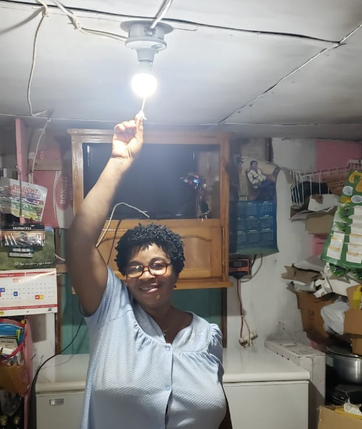 The second customer to get connected pulls on the light switch for the first time in her business. The second customer to get connected pulls on the light switch for the first time in her business. [TIBURON, HAITI, Dec. 21]: EarthSpark International launched its second solar-powered microgrid in Haiti today. The system is the first community-power grid to be approved under Haiti’s new national regulatory body. Building on EarthSpark’s model of community-scale smart solar infrastructure, the grid will serve 500 homes and businesses with 24/7 electricity in Tiburon, a small fishing town in the southern peninsula. The launch marks a major step in mainstreaming microgrid power in Haiti. “Microgrids hold enormous potential to quickly bring electricity to communities across rural Haiti. For 10 years now, EarthSpark and our Haitian affiliate Enèji Pwòp have been building a foundational track record of clean energy delivery in rural Haiti,” says Allison Archambault, President at EarthSpark International. “The launch of the Tiburon grid is a success story for multi-sector partnerships building a market that can scale-up to sustainably electrify the 70% of the Haitian population still living without electricity.” To achieve the launch, EarthSpark worked closely not only with the community of Tiburon, but also with local and national elected officials, with the national regulatory authority, the national electricity company Électricité d’Haïti, the Haitian engineering firm DigitalKap, and with international stakeholders including the US Agency for International Development and the World Bank to inform practical and policy next steps. "The government is committed to improving electricity access in rural regions by deploying smart microgrids in more than 51 sites. Today, with the collaboration of EarthSpark and Enèji Pwòp, we did it in Tiburon in the South Department. This is the first provisional license for a community microgrid ever signed by the regulatory authority for the energy sector," said Dr. Evenson Calixte, Director of the National Regulatory Authority (ANARSE). In addition to being a point of progress for clarification in the legal and regulatory environment for energy in Haiti, the Tiburon grid also represents a point of resilience in the face of natural disasters. Tiburon was hit hard in 2016 by Hurricane Matthew. Though EarthSpark had already secured funding and local support for the grid, the storm brought down pre-existing poles and wires. USAID and the Haitian government provided support to rebuild the distribution system and to complete the full construction of the grid. The Tiburon grid is a 95kW solar smart grid that offers a clean, 24-hour, and affordable electricity for homes and businesses which had never before had access to reliable grid electricity. The grid has a backup diesel genset – the last genset EarthSpark will install as it transitions to 100% solar power for future grids. Customers, energy vendors, and grid managers interact with the grid through the SparkMeter utility interface which enables pre-payment billing, load management, and theft detection to ensure efficient operations. EarthSpark’s microgrids directly achieve the United Nation’s seventh Sustainable Development Goal (SDG), affordable and clean energy, while unlocking opportunities to progress all 17 goals including:
As of today, residents of Tiburon will join a small handful of communities in the Caribbean nation with reliable 24-hour electricity. The grid was funded primarily by the OPEC Fund for International Development with additional support from USAID, The Pan-American Development Foundation, the Organization of American States, and individual donors. To see events from the launch, customer profiles and more, follow us on Facebook and Twitter at @EarthSparkIntl. Of Insects and Lightning: Unexpected Realities of Operating in a Challenging Business Environment11/26/2019 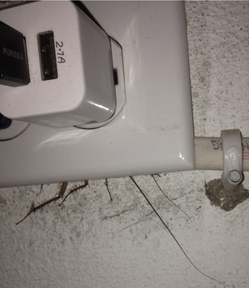 Beetle buried in electrical plug Beetle buried in electrical plug By Andy Bilich An audible crunch and a real (ok, maybe imagined) hiss are not what you expect when plugging in your phone, but that’s exactly what greeted me a few weeks ago when I accidentally squished a beetle inside my electrical outlet. Bugs are not exactly top of mind when you think of the business of solar microgrids, but over the past few months about 5% of customers have lost plugs due to the presence of ants and other insects. While the cost to replace an outlet is nominal, plug problems nonetheless interrupt service for customers and take technician time away from other work. Beyond bugs, lightning looms as another significant risk for microgrid operations, particularly customer meters. In the last few months 24 meters have been damaged by lightning strikes and surges. The meters range in price based on the level of electricity service they support, but even the most modest meters cost around $35 USD. Larger meters used for grid management cost upwards of $150 each. To account for these operational risks, EarthSpark stocks backup inventory, but more importantly the team must integrate technology, systems, and processes that proactively manage these risks. This includes surge protection devices, efficient protocol for responding to lighting strikes on our electricity poles and customer outreach and training on plug maintenance and protection. Microcosm of a challenging business environment for microgrids Of course, lightning and insects are a microcosm of a larger, more challenging business and operating environment for energy access in Haiti. Haiti is ranked 182 out of 190 countries in the World Bank Doing Business Rankings which systematically measures how difficult it is to conduct business in a given country across a variety of metrics. For Haiti, this difficulty is particularly reflected in commercial banking, the regulatory environment, and the cost of procurement of materials and land. Navigating these challenging yet essential business processes are all further complicated by the remote locations of EarthSpark’s microgrids, with limited infrastructure and high costs associated with transportation. When we hire a delivery truck, for example, we need to be sure it can navigate crossing the Les Anglais riverbed, and we work to time things so that the river is not too high to cross when the shipment makes the journey. The World Bank’s Scaling Renewable Energy Program (SREP) Investment Plan for Haiti highlights that renewable energy projects, and microgrids in particular, face additional operational challenges including but not limited to:
Derisking by doing Well aware of these challenges, EarthSpark is nevertheless moving microgrids forward in Haiti. We describe our approach as ‘de-risking by doing’. While good planning and critical thinking are essential elements of building a sector, only by building actual grids in real towns and having real-world conversations with policy makers and funders will we uncover the full set of challenges and their remedies. EarthSpark’s push for pioneering infrastructure is helping to determine how infrastructure is defined and regulated in Haiti and beyond:
No Shortage of Opportunities – How a Solar Microgrid is Providing Resiliency in Uncertainty9/16/2019 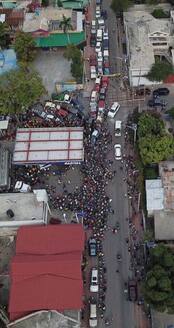 Long queues for fuel are now a common occurrence in Port-au-Prince. Long queues for fuel are now a common occurrence in Port-au-Prince. It was mid-day when Wendy got the call from the neighboring town. “Do you have any diesel?” the caller asked. It’s a common question in Haiti right now. Fuel shortages have been creeping along for weeks. Most major gas stations in Port-au-Prince are intermittently closed and rationing and very little fuel is getting beyond the capital. Since the majority of electricity in the country comes from burning imported fossil fuels, fuel crises – more frequent now – directly lead to grid electricity shutting off for hours, days, or weeks – even more than usual. Les Anglais, where 100% of the electricity supply is coming from solar energy these days, is an exception. “We might be the only grid in the country providing 24/7 power” speculated Wendy Sanassee, Director of Haiti Operations for EarthSpark. A shining example of 24/7 clean, reliable power in Haiti In a shining example of the value and effectiveness of solar microgrids in delivering reliable electricity to communities in rural Haiti, the Les Anglais system leverages a solar+battery system (100 kw of solar + 208 kWh of storage) coupled with smart meters and a focused effort on community energy literacy and the development of local enterprises – known as “Productive Use of Energy” – to provide reliable, affordable, and clean power to a significant and growing number of households and businesses (over 450 existing customers with over 100 new customers signed up for an upcoming grid expansion). While the Les Anglais system has a diesel generator backup, it is now rarely used for day-to-day operations. In fact, during the month of August and the first week and a half of September, the generator in Les Anglais ran a total of about 2 hours – mostly for scheduled maintenance and a momentary system fault during recent lightning storms. Indeed, EarthSpark is planning to phase out diesel completely in favor of 100% renewable energy for its future grids. Climate change and the impending need for expanded resiliency With high reliance on imports, limited budgets, constrained transportation and logistics, as well as other acute stressors like political instability and natural disasters, supply disruptions and system shocks like the current diesel shortage are unfortunately common in developing economies – especially in island nations with complex business environments[1] like Haiti. To compound issues, these disruptions and their underlying socioeconomic, political, and environmental contexts are likely to be exacerbated by the expanding climate crisis. Haiti is ranked as the most vulnerable country in the Americas to climate change (and is frequently among the most vulnerable in the world.) Of the expected climate change impacts[2] [3] [4] [5], the higher frequency and intensity of extreme weather events such as hurricanes and their consequential flooding, is particularly concerning for Haiti as more than 93% of the country and more than 96% of the population are exposed to these natural disasters with the poorest Haitians, including low-income women, children, and elderly people, particularly vulnerable. To proactively respond to existing disruptions and the future threats presented by climate change, communities in Haiti and beyond need energy solutions that are both reliable and resilience-boosting. Solar microgrids enable long-term community resiliency Establishing a foundation of clean, reliable, and affordable electricity through solar microgrids not only directly addresses the issue of energy poverty by providing energy access to off-grid communities, but it can also fundamentally change how these communities are able to effectively plan for and cope with shocks – like a diesel shortage, hurricane, or climate change – by enabling new technology, approaches, and indeed resources for long-term adaptation and resiliency. By boosting businesses and livelihood opportunities and also simply reducing energy expenditures from the baseline (~80% savings for households and 50% savings for businesses compared to the status quo fuels), microgrids provide for both income availability and income stability for households which improves their ability to adapt and respond to crisis. By enabling use of agricultural processing equipment (mills, threshers, grinders, dryers, etc.), storage and handling technology (refrigeration, crop drying, packaging, etc.) as well as cold chain for transportation, solar microgrids can help to improve food security (particularly for rural communities that are more logistically isolated from central food supply networks) by reducing post-harvest food loss, improving food quality, increasing access to nutritious foods, and controlling timing of sales.[6] [7] Microgrids can also support the deployment of other new technologies (i.e. water pumping, refrigeration, medical equipment etc.), which can potentially unlock greater opportunity for and stability of other basic services most notably health, communications, and water availability. [8] Microgrids can also enable a higher level of connectivity to outside financial and informational resources and systems, particularly by encouraging the adoption of mobile money applications and enhancing the stability of communication services.[9] Microgrids can further provide a measure of resilience for communities by islanding electric service and critical operations like health clinics, food distribution, etc. and reducing recovery time following disruptions. This is in addition to the intrinsic resilience that microgrids provide due to the nature of their distributed, modular construction that does not rely on long, vulnerable power distribution systems to deliver electricity. [10] [11] Expanding microgrid opportunities for Haitian communities Especially amidst the backdrop of ongoing and future uncertainty, the Les Anglais (and Tiburon[12]) microgrids provide a critical blueprint for energy resiliency and highlight that there is no shortage of opportunity for solar microgrids to provide clean, reliable energy access to communities across Haiti. In fact, with its 2015 national microgrid market study, EarthSpark and its Haitian partner Enèji Pwòp made the case that over 80 towns across Haiti would be strong candidates for solar microgrids. As EarthSpark works towards turning on grid #2, it is also working toward the scale-up plan for the next 22 towns. With the right kind of financing and a streamlined regulatory environment to better support microgrid deployment, and operations, many more towns across Haiti could soon see their critical services delivered in spite of national fuel shortages, future natural disasters, or whatever else awaits. With more secure access to energy and related resilience, those living in rural Haiti can unlock the true potential of their communities. Footnotes [1] Haiti is ranked 182 out of 190 countries in the World Bank Doing Business Rankings which systematically measure how difficult it is to conduct business in a given country across a variety of metrics. [2] Oxfam, Climate Change Resilience: The Case of Haiti (2014), Available at: https://www-cdn.oxfam.org/s3fs-public/file_attachments/rr-climate-change-resilience-haiti-260314-en_2.pdf [3] UNDP, Estimation des couts des impacts du changement climatique en Haiti (2015; Available at: https://www.undp.org/content/dam/haiti/docs/Protection%20de%20l%20environnement/UNDP-HT-ProEnv-EtuEconoCC.pdf [4] USAID, Climate Risk Profile – Haiti (2017; Available at: https://www.climatelinks.org/sites/default/files/asset/document/2017_Cadmus_Climate-Risk-Profile_Haiti.pdf [5] Haiti Second National Communication on Climate Change (2002), Available at: https://unfccc.int/resource/docs/natc/htinc2.pdf [6] World Food Programme, “Energy for Food Security” (2019); Available at: https://reliefweb.int/sites/reliefweb.int/files/resources/WFP-0000106572.pdf [7] SEAR, Energy Access for Food and Agriculture; Available at: http://documents.worldbank.org/curated/en/417941494928698197/pdf/115062-BRI-P148200-PUBLIC-FINALSEARSFFoodandAgrigcultureweb.pdf [8] World Food Programme, “Energy for Food Security” (2019); Available at: https://reliefweb.int/sites/reliefweb.int/files/resources/WFP-0000106572.pdf [9] IRENA, Off-grid renewable energy solutions to expand electricity access: An opportunity not to be missed (2019); Available at: https://www.irena.org/-/media/Files/IRENA/Agency/Publication/2019/Jan/IRENA_Off-grid_RE_Access_2019.pdf [10] Siemens, “Resilient by Design: Enhanced Reliability and Resiliency for Puerto Rico’s Electric Grid” (2018), Available at: https://microgridknowledge.com/white-paper/mini-grids/ [11] NREL, Distributed Generation to Support Development-Focused Climate Action (2016); Available at: https://www.nrel.gov/docs/fy16osti/66597.pdf [12] It is important to highlight that this one town example could easily be two towns as Enèji Pwòp has another microgrid ready to be turned on in the nearby town of Tiburon – but it is awaiting regulatory sign off. By Adam Eberwein & Madie Sturgess How many times did you interact with electricity before you left the house this morning? There are countless thoughtless touch points from when we turn off the alarm to when we flick the last switch on our way out of the house. Consider for a moment how your routine would change if, due to unexpected soaring costs of electricity, you had to budget for and ration your energy use. Chances are it would change how often you used your phone or laptop, what kinds of food you’d prepare, and when you’d go to sleep. When an under-electrified nation seeks to solve its energy crisis, determining what electricity should cost becomes more than a business plan or household accounting. The accessibility of electricity impacts culture, prosperity, and opportunity, and the costs – borne ultimately by customers, governments, or donors -- depend on policy, technology, and delivery structure. The question, “what should electricity cost”, is critical to EarthSpark as we work with communities to build a model for decentralized, cleantech-enabled, energy infrastructure across Haiti. EarthSpark’s growing field operations are generating some real-world data necessary to help answer that question. Some of the latest figures from microgrid operations in Haiti are beginning to reveal the social and economic impacts EarthSpark’s microgrid energy is having on household and business. Phone Use Like in the US, Haiti’s rural communities depend on phones in daily life even though in Haiti charging a phone can be an expensive prospect involving a hike to the nearest phone charging business. Consequently, diesel generators (personal and small businesses) offer the primary source for phone charging, becoming a necessary and costly expense to the average household’s already tight budget. In Les Anglais, our grid-connected customers have reported savings of 90% compared to their pre-grid phone charging expenses. More reliable and affordable access to phones gives customers greater access to information and opens opportunity for a mobile money economy to flourish. A change in affordability like this opens access to and participation in local, regional, and global markets in addition to news and information. Access to Freezers Households and businesses with grid-connected freezers are spending 45% less on electricity to reliably power their appliance. This makes freezers powered by a personal generator, nearly two times more expensive than its clean-powered alternative. Being able to afford to reliably power a freezer improves food security, nutrition, and economic opportunity. Local agricultural producers can nominally reduce post-harvest losses, households can store a diversity of foods for longer, and greater opportunities for small businesses arise. With inaccessibly high electricity tariffs these opportunities disappear, and with well-intentioned cheap tariffs these opportunities arise for a time but inevitably disappear as the operational model of the grid is unable to sustain operations and maintenance costs. In our team’s experience in Haiti, microgrid users’ adoption of freezers or fridges is an important step towards their adopting other income-generating equipment. The freezer holds the necessary combination of both a well-established and understood tool and a source of aspiration for many small businesses, with the ability to unlock new sources of income that were never before sustainable in this context. Our team has seen successful freezer utilization lead to adoption of tools requiring greater investment and savvy. Lighting In off-grid communities, kerosene lamps and candles are frequently used for lighting, releasing hazardous air pollutants, while delivering only poor lighting quality. When EarthSpark customers connect to the grid, they put away their candles and kerosene lamps and instead flip the switch on for LED lighting that is cleaner, more affordable, and shines as much as 250 times brighter than pre-grid lighting (on a lumens per watt basis). Households with quality lighting are often associated with better conditions for education and home-based work and displace air pollutants responsible for 8000 premature deaths a year across Haiti. Household Economics: Comparing pre-grid energy, microgrid energy, US grid energy expenses The Challenge of Electric Cooking Like EarthSpark, many microgrid developers have found some success in quantifying the cost to electrify household and community activities. Cooking, however, remains a rarely-touched area for microgrid operators. Transitioning communities from charcoal to electric cooking requires a model offering an affordable service that also meets the energy demands of local cooking habits. There is currently insufficient data to confidently determine the average household spend on charcoal powered cooking activities. Below is a table of a recent 9 customer sample recently taken in Tiburon which demonstrates this dearth of meaningful data. EarthSpark is currently pursuing technical and anthropological studies of the electrification of cooking to generate much needed data. By identifying the energy, time, and cost associated with local cooking habits and recipes, we aim to determine a pathway to electric cooking tariffs with competitive price points. Solving the cost of electric cooking makes a more robust case for the adoption of microgrid infrastructure in emerging markets. Fundamentally, moving a microgrid model towards market must affordably meet the end user’s need. A genuinely sustainable model must also be capable of meeting operations and maintenance costs, and electricity access will only ever scale if the operations model includes sufficient revenues to pay (even subsidized) costs of capital. Striving to balance these competing needs, opens the conversation about the government’s role, be it by providing an enabling regulatory environment, offering subsidies, managing exchange rate fluctuations, or setting tariffs.
There is often a false expectation that renewable energy infrastructure must be solely rooted in the private sector to be considered a compelling fossil fuels alternative. And yet, globally oil, coal, and gas continue to receive $5.2 trillion a year in subsidies. These are exceptional heights of public investments for an industry that’s more than a century old and that carries such high social, economic, and environmental costs. Determining asset ownership only further highlights the need to define the role of public and private participation in energy access. “What should electricity cost”, is a complex question that reveals how scaling an electrification model requires more than possessing a promising, technical innovation. Social, regulatory, and cultural challenges persist. These same challenges are relevant not just in other emerging markets but underly the global energy transition. |
EarthSpark supporters make our work possible. Thank you for considering a donation towards eliminating energy poverty in Haiti.
Read the full blog - click here!
|
EarthSpark International is a non-profit 501(c)3 organization.

